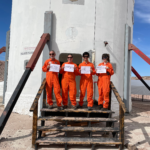Journalist Report Oct 03rd
Crew 228 Journalist Report 03OCT2021
Author: Marufa Bhuiyan, Remote Crew Astronomer
Title: A mathematical poem on Mars and simulation of our mind
I.
You are the M-STAR, Eon of our generation and messenger of peace
Please tell us your stories and dreams, and where you’d like to go next.
Is it the Moon or Mars or Earth bound again?
Towards the Andromeda or in a different galaxy far away…
Which galaxy would you like to reside in? Then please CONTACT 3021.
II.
Maybe you will ‘time travel’ thousands of years
Please follow your “Imaginary time” at a 45 degree angle,
Carry your trinity in a style, or who knows you might fall into a beautiful Triangle.
If you could travel faster than lights, how old would you be?
You know they say “age” is just a number. Here’s a simple math, 1+2+3+4+5+6+7 = 28.
If you were sure of your immortality, would you live your life differently?
III.
Mr. Robert Frost said long ago “The Prophets really Prophecy as Mystics,
the Commentators Merely by Statistics”
Wherever you want to go my friend, “May the Force be with You”.
When we see a ‘bright star’ every now and then,
And we have a moment to think, “we will think of you”.
Hopefully someday we meet on Earth
‘In between our dreams’ or, in an interstellar journey on my rocket ‘88!
Until then, please take good care of your health and be happy.
IV.
So, the relationship with Mr. ‘X’ which had begun like an opening to the heavens,
Had sizzled in the middle when I believed I had outsmarted the Gods,
finally ended with a rude Earth landing!
Back to Eden? Enjoy the speed of your journey.
V.
Please remember, you are the chosen one, the best of the best,
“But you, children of space, restless in rest, you shall not be trapped nor tamed.”
When I was at MDRS in an analog astronaut training, oh it was not too long ago!
It was about our red planet, it was at the Mars Desert Research Station (#220) in 2020,
Now it seems so long ago!
At that time, I learned as a Crew Astronomer: “Please do not trigger others with your actions or words.”
and “Stay kind, it makes you beautiful.”
Science Report Oct 03rd
Science Report 03OCT2021
Crew Scientist / GreenHab Officer Inga Popovaite
Science Report
Lindsay:
Today, Lindsay continued to investigate reddish-brown regolith she collected from five locations along the slopes of the Jotunheim structure, an inverted river bed located approximately two kilometers North of the HAB at 38.41712 N, -110.78466 W (NAD27). The regolith were collected from the same geographical feature sampled by Maggiori et al. (2020), who confirmed the presences of microbes from all three kingdoms of life, including extremophiles that could potentially survive the harsh elements of the Martian environment, such as psychrophiles, halophiles, and UV-resistant microorganisms. In the ScienceDome, Lindsay began to extract DNA using a Soil DNA Isolation Plus Kit (Product #64000, Norgen Biotek Corp) and will then prepare the DNA samples into libraries using the Field Sequencing Kit (SQK-LRK001, Oxford Nanopore Technology). To simulate the lack of state of the art facilities in the rudimentary martian science labs, she used human power to lyse the cells instead of using micro-centrifuge or vortexes. Her protocol will take much longer than usual and she will assess how this alternative process will affect the yield of the DNA.
She will then use the handheld DNA sequencer MinION to basecall and sequence the libraries and the MinKNOW software to perform metagenomics analyses on the reads from the MinION. Overall, this process will allow Lindsay to identify what organisms, if any, are present in the regolith samples. She aims to validate the findings of Maggiori et al. (2020), only now conducting the complete experimental process from regolith sample collection to metagenomics analysis while undergoing planetary exploration simulation at MDRS, all as a proof-of-concept that metagenomics studies can be completed in-situ in this remote environment. Lidsay began to extract DNA from her samples.
Jin:
Jin came with a plan to test software predictions of potential radio blackout spots using viewshed analysis. Crew 228 plans an EVA tomorrow to test this.
Inga:
As the lead author of today’s report I want to tell more about my study in general. I am studying small mixed gender crew interactions. There is no significant gender difference in task performance and physical adaptation in isolated, confined, and extreme environments (Harm et al. 2001; Kanas and Manzey 2008; Mark et al. 2014). Mixed-gender crews are praised as more efficient, cohesive, and with overall better team climate than men-only teams. But at the same time gender differences are recognized as a source of additional tension in a crew (Bishop 2004; Kahn and Leon 2000; Kring and Kaminski 2012; Leon 1991, 2005). In my dissertation I aim to investigate gender inequality and differences from a socio-tructural point of view in order to help to send a well-functioning group of women and men to Mars.
The first two chapters of the dissertation use reports from the previous MDRS crews. In Chapter 1 I use multilevel generalized regression models to show that women on average participate in six percentage points less EVAs than men (p<.05) controlling for their crew role, education, previous analog experience, number of women in the crew, and commanders’ gender. A paper based on this chapter is accepted for publication at the Journal of Human Performance in Extreme Environments.
Chapter 2 utilizes commanders’ reports from 2009-2016 and looks at communal and agentic aspects of leadership behavior. Sentiment analysis results showed that female commanders are statistically significantly (p<.001) more positive in their reports than their male counterparts. Qualitative analysis results demonstrated that both male and female commanders are agentic, but male commanders talked more about maintenance issues, and did it in a more negative tone in comparison to female commanders. Commanders of both genders were communal, but male commanders focused on crew cohesion in terms of team spirit, and women emphasized mutual support. Proportional word frequencies confirmed that commanders of both genders are agentic, but women tend to use more general terms and men use more specific terms in their reports. Female commanders used more communal words than male commanders. Overall, the results are in line with previous social role theory research and show that commanders of both genders are agentic (but with granular differences), and female commanders tend to be more communal. This paper is currently under peer review.
Currently at MDRS I collect ethnographic (participant observation) data for the last chapter of my dissertation. In addition to rich original data, this chapter will provide context to the rest of the project.
And last but not least, crew 228 is helping me to pilot a future journal study of emotion and emotion management. A significant body of empirical psychological research on mixed-gender crews in space analog environments reaffirm gender stereotypes: women are more other-oriented and care more about the wellbeing of others, and men are more individualistic and competitive (Bishop et al. 2010; Kahn and Leon 2000; Leon 2005). Emotional behavior in this line of research is seen as an intrinsic part of a personality. I approach emotions and emotion management as aspects of a social structure. Emotional behavior is closely intertwined with an individual’s gender and status. Emotion management is a conscious attempt to align one’s emotions with situational emotion rules (Hochschild 1983). This future study will examine emotion management and unwritten emotion rules in space analog environments.
References:
Bishop, Sheryl L. 2004. “Evaluating Teams in Extreme Environments: From Issues to Answers.” Aviation, Space, and Environmental Medicine 75(Suppl 7):C14-21.
Bishop, Sheryl L., Ryan Kobrick, Melissa Battler, and Kim Binsted. 2010. “FMARS 2007: Stress and Coping in an Arctic Mars Simulation.” Acta Astronautica 66(9):1353–67. doi: 10.1016/j.actaastro.2009.11.008.
Harm, Deborah, Richard Jennings, Janice Meck, Michael Powell, Lakshmi Putcha, Clarence Sams, Suzanne Shneider, Linda Shackelford, Scott Smith, and Peggy Whitson. 2001. “Genome and Hormones: Gender Differences in Physiology. Invited Review: Gender Issues Related to Space Flight in NASA Perspective.” Journal of Applied Psychology (91):2374–83.
Hochschild, Arlie Russell. 1983. The Managed Heart: Commercialization of Human Feeling. Berkeley: University of California Press.
Kahn, P., and G. Leon. 2000. “Group Climate & Individual Functioning in an All-Women Antarctic Expedition Team.” Journal of Human Performance in Extreme Environments 5(1). doi: 10.7771/2327-2937.1005.
Kanas, Nick, and Dietrich Manzey. 2008. Space Psychology and Psychiatry. Springer Science & Business Media.
Kring, Jason P., and Megan A. Kaminski. 2012. “Gender Composition and Crew Cohesion During Long-Duration Space Missions.” in On Orbit and Beyond: Psychological Perspectives on Human Spaceflight, edited by D. A. Vakoch. Springer Science & Business Media.
Leon, G. R. 2005. “Men and Women in Space.” Aviation, Space, and Environmental Medicine 76(6 Suppl):B84-8.
Leon, Gloria R. 1991. “Individual and Group Process Characteristics of Polar Expedition Teams.” Environment and Behavior 23(6):723–48. doi: 10.1177/0013916591236005.
Maggiori, Catherine, Jessica Stromberg, Yolanda Blanco, Jacqueline Goordial, Edward Cloutis, Miriam García-Villadangos, Victor Parro, and Lyle Whyte. 2020. “The Limits, Capabilities, and Potential for Life Detection with MinION Sequencing in a Paleochannel Mars Analog.” Astrobiology 20(3):375–93. doi: 10.1089/ast.2018.1964.
Mark, Saralyn, Graham B. I. Scott, Dorit B. Donoviel, Lauren B. Leveton, Erin Mahoney, John B. Charles, and Bette Siegel. 2014. “The Impact of Sex and Gender on Adaptation to Space: Executive Summary.” Journal of Women’s Health (2002) 23(11):941–47. doi: 10.1089/jwh.2014.4914.
Sol Summary Report Oct 03rd
Crew 228 Sol Summary Report 03OCT2021
Sol: 6
Summary Title: Mid Way
Author’s name: David Laude XO/Crew Engineer
Mission Status: Going as planned.
Sol Activity Summary: We started the day with a simple cereal breakfast offered by Dave featuring the granola extracted from Dave’s personal supply ship yesterday at the end of EVA#4. Granola was missing in our food supply. After breakfast we discussed the day’s activities. Today is the least active of all so far and happens to coincide with today being Sunday. Water was delivered to the static tank. We quietly worked on our research projects and planned for tomorrow’s EVA including some ideas for a couple more. A terrific hot potato casserole lunch was prepared and served by Jin. At lunch we watched an episode of "Moon Base 8". It’s a comedy regarding a moon base analog in Arizona that looks generally like MDRS. This episode focused on running out of water and a deadly attempt to remedy the situation by a crew member digging a well and falling into a cave-in. About 10 radios were tested for functionality and battery condition. One or two suspect radios and a failed battery were identified. A few more of both will be tested in the next few days.
Look Ahead Plan: EVA tomorrow morning. Ongoing research project work at hab.
Anomalies in work: None.
Weather: Warm (80F) and sunny. No Storms.
.
Crew Physical Status: All crew nominal.
EVA: None today.
Reports to be filed: Science, Journalist, Crew Photos, EVA request and this Sol Summary
Support Requested: None.






You must be logged in to post a comment.